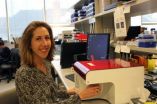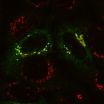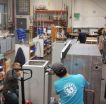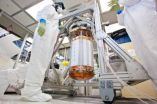(Press-News.org) COLUMBIA, Mo. — Congenital heart disease is the most common form of birth defect, affecting one out of every 125 babies, according to the National Institutes of Health. Researchers from the University of Missouri recently found success using a drug to treat laboratory mice with one form of congenital heart disease, hypertrophic cardiomyopathy — a weakening of the heart caused by abnormally thick muscle. By suppressing a faulty protein, the researchers reduced the thickness of the mice's heart muscles and improved their cardiac functioning.
Maike Krenz, M.D., has been studying hypertrophic cardiomyopathy for more than 10 years, soon after a gene was discovered in 2001 that linked the disease to the genetic conditions Noonan syndrome and LEOPARD syndrome. In Noonan and LEOPARD syndromes, the thickened heart muscle of hypertrophic cardiomyopathy is caused by a defective Shp2 protein, created by a mutation in the gene PTPN11.
"Previously, not much has been known about the biochemistry behind Shp2 and hypertrophic cardiomyopathy," said Krenz, an assistant professor of medical pharmacology and physiology at the MU School of Medicine, and a researcher at MU's Dalton Cardiovascular Research Center. "We know the thickened heart muscle is sick and doesn't work properly, and we know a defective Shp2 protein can cause heart muscle to thicken. However, to create an effective treatment, we need to know what Shp2 is doing inside the heart to cause the defect."
To test whether they could interrupt the heart's hypersensitivity to growth signals, the researchers gave a chemical compound, PHPS1, to mice with a mutated gene that produces the defective Shp2 protein.
"Not only did the compound reduce the thickness of the heart muscle to the size of normal heart muscle, but it also improved the cardiac pumping of the heart," Krenz said. "That's important because people with hypertrophic cardiomyopathy have an increased risk of sudden cardiac death. If we could develop an effective treatment for the disease and improve patients' heart function, we would be able to improve health outcomes for these patients."
Because of the role Shp2 plays in signaling heart growth, Krenz believes the research could be translated in the future into improved treatments for other types of heart disease, such as damage caused by heart attack.
INFORMATION:
Krenz presented the research findings, "Inhibition of Shp2's Phosphatase Activity Ameliorates Cardiac Hypertrophy in LEOPARD Syndrome Models," at the American Heart Association's Scientific Sessions conference in November 2013, where it received the Outstanding Research Award in Pediatric Cardiology. LEOPARD syndrome is related to Noonan syndrome and receives its name from an acronym for multiple lentigines, electrocardiographic conduction abnormalities, ocular hypertelorism, pulmonic stenosis, abnormal genitalia, retardation of growth and deafness.
NOTE TO REPORTERS AND EDITORS:
For a portrait photo of Maike Krenz, contact Colin Planalp at (573) 884-1935 or planalpc@health.missouri.edu.
Compound improves cardiac function in mice with genetic heart defect, MU study finds
2014-02-20
ELSE PRESS RELEASES FROM THIS DATE:
Turning back the clock on aging muscles?
2014-02-20
A study co-published in Nature Medicine this week by University of Toronto researcher Penney Gilbert has determined a stem cell based method for restoring strength to damaged skeletal muscles of the elderly.
Skeletal muscles are some of the most important muscles in the body, supporting functions such as sitting, standing, blinking and swallowing. In aging individuals, the function of these muscles significantly decreases.
"You lose fifteen percent of muscle mass every single year after the age of 75, a trend that is irreversible," cites Gilbert, Assistant Professor ...
Researchers say distant quasars could close a loophole in quantum mechanics
2014-02-20
In a paper published this week in the journal Physical Review Letters, MIT researchers propose an experiment that may close the last major loophole of Bell's inequality — a 50-year-old theorem that, if violated by experiments, would mean that our universe is based not on the textbook laws of classical physics, but on the less-tangible probabilities of quantum mechanics.
Such a quantum view would allow for seemingly counterintuitive phenomena such as entanglement, in which the measurement of one particle instantly affects another, even if those entangled particles are ...
Crop species may be more vulnerable to climate change than we thought
2014-02-20
A new study by a Wits University scientist has overturned a long-standing hypothesis about plant speciation (the formation of new and distinct species in the course of evolution), suggesting that agricultural crops could be more vulnerable to climate change than was previously thought.
Unlike humans and most other animals, plants can tolerate multiple copies of their genes – in fact some plants, called polyploids, can have more than 50 duplicates of their genomes in every cell. Scientists used to think that these extra genomes helped polyploids survive in new and extreme ...
Surprising culprit found in cell recycling defect
2014-02-20
To remain healthy, the body's cells must properly manage their waste recycling centers. Problems with these compartments, known as lysosomes, lead to a number of debilitating and sometimes lethal conditions.
Reporting in the Proceedings of the National Academy of Sciences (PNAS), researchers at Washington University School of Medicine in St. Louis have identified an unusual cause of the lysosomal storage disorder called mucolipidosis III, at least in a subset of patients. This rare disorder causes skeletal and heart abnormalities and can result in a shortened lifespan. ...
MD Anderson researcher uncovers some of the ancient mysteries of leprosy
2014-02-20
Research at The University of Texas MD Anderson Cancer Center is finally unearthing some of the ancient mysteries behind leprosy, also known as Hansen's disease, which has plagued mankind throughout history. The new research findings appear in the current edition of journal PLOS Neglected Tropical Diseases. According to this new hypothesis, the disease might be the oldest human-specific infection, with roots that likely stem back millions of years.
There are hundreds of thousands of new cases of leprosy worldwide each year, but the disease is rare in the United States, ...
Sustainable manufacturing system to better consider the human component
2014-02-20
CORVALLIS, Ore. – Engineers at Oregon State University have developed a new approach toward "sustainable manufacturing" that begins on the factory floor and tries to encompass the totality of manufacturing issues – including economic, environmental, and social impacts.
This approach, they say, builds on previous approaches that considered various facets of sustainability in a more individual manner. Past methods often worked backward from a finished product and rarely incorporated the complexity of human social concerns.
The findings have been published in the Journal ...
New calibration confirms LUX dark matter results
2014-02-20
PROVIDENCE, R.I. [Brown University] — A new high-accuracy calibration of the LUX (Large Underground Xenon) dark matter detector demonstrates the experiment's sensitivity to ultra-low energy events. The new analysis strongly confirms the result that low-mass dark matter particles were a no-show during the detector's initial run, which concluded last summer.
The first dark matter search results from LUX detector were announced last October. The detector proved to be exquisitely sensitive, but found no evidence of the dark matter particles during its first 90-day run, ruling ...
Better broccoli, enhanced anti-cancer benefits with longer shelf life
2014-02-20
URBANA, Ill. – While researching methods to increase the already well-recognized anti-cancer properties of broccoli, researchers at the University of Illinois also found a way to prolong the vegetable's shelf life.
And, according to the recently published study, the method is a natural and inexpensive way to produce broccoli that has even more health benefits and won't spoil so quickly on your refrigerator shelf.
Jack Juvik, a U of I crop sciences researcher, explained that the combined application of two compounds, both are natural products extracted from plants, increased ...
Smaller meals more times per day may curb obesity in cats
2014-02-20
URBANA, Ill. – Just as with people, feline obesity is most often linked to excessive food intake or not enough physical activity. Attempts to cut back on calories alone often result in failed weight loss or weight regain in both people and their pets.
So how do you encourage your cat to get more exercise?
Researchers from the University of Illinois interested in finding a method to maintain healthy body weight in cats, looked at a previously suggested claim that increased meal frequency could help to increase overall physical activity.
The idea is to feed cats the ...
Color vision problems become more common with age, reports Optometry and Vision Science
2014-02-20
Philadelphia, Pa. (February 20, 2014) - Abnormal color vision increases significantly with aging—affecting one-half or more of people in the oldest age groups, reports a study in Optometry and Vision Science, official journal of the American Academy of Optometry. The journal is published by Lippincott Williams & Wilkins, a part of Wolters Kluwer Health.
While few people younger than 70 have problems with color vision, the rate increases rapidly through later decades of life, according to the new research by Marilyn E. Schneck, PhD, and colleagues of The Smith-Kettlewell ...




